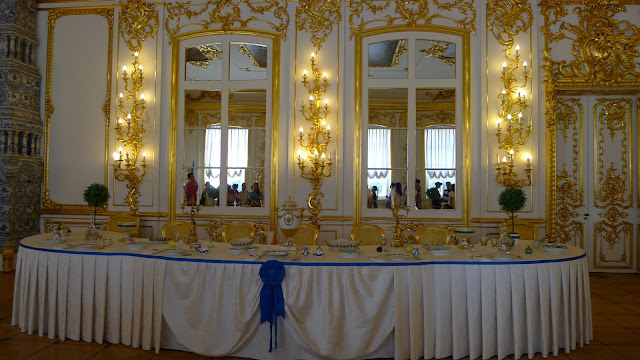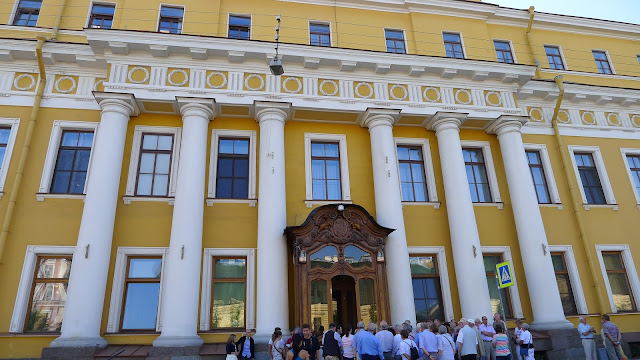Last week we had a wonderful trip to Moscow and St. Petersburg. It is impossible to show you even half of
what we saw as I took nearly 800 pictures. But I have tried to pick out the highlights and hope that the pictures I
have chosen will give you a glimpse into Russian History. Our tour guides were great so I will include
a few of their insights that hopefully
will make the pictures more meaningful.
We started our trip in Moscow. I have to say that I was really impressed with Moscow. It is a city of about 12 million and the
amount of building is incredible. It is
a very modern city with a lot of history mixed in and that is where I put my
focus…..the history.
 |
| One of Stalin's Seven Sisters - all exactly alike |
The morning we arrived we didn’t have a guide so we took a two hour
bus tour around the city. It was very
informative and gave us a feel for the layout of our surroundings. We knew that in two days we would never get
to see even a small part of all the things we would have liked but we did get
to see more than I thought we would. We
first went to Red Square and the Kremlin. Red Square isn’t what I had imagined or even as big as I thought it would be after reading about all
of the events that have taken place there, but it is very interesting.
 |
| Entry Gate to Red Square |
 |
| Red Square |
 |
| Orthodox Church on Red Square |
There were museums, churches
and my favorite, St. Basil’s Cathedral the most photographed church in Moscow. This is the most recognizable of all the cathedrals in Moscow and was
built in 1561 to celebrate the victory of Ivan the Terrible over the Kahn of
Kazan. Two architects from Italy were
hired to design and build it. After it was
finished, Ivan asked them if it would ever be possible to recreate this same
building. Thinking that he might want to
build another one like it somewhere else, they enthusiastically said “yes.” He immediately had their eyes put out, so
that they would not be able to recreate it. A little miscommunication but fortunately it did not cost them their
lives. The cathedral is as beautiful on
the inside as on the out. What we all
should be, right?
 |
| St. Basil's Cathedral |
 |
| Inside St. Basil's |
 |
| Inside St. Basil's Cathedral |
 |
| Front of St. Basil's Cathedral |
The State History Museum is two floors of extensive Russian History.
 |
| Historical Museum at Entrance to Red Square |
The Kremlin formed the heart of the ancient city, which to this day
houses the political headquarters of the world’s geographically largest
nation. There are of course several
areas that are off bounds to tourists but there is plenty to see there
including about four churches, the Ivan the Great Bell Tower, the Kremlin Armory
and The Patriarch’s Palace which is a museum.
 |
Canal Tour
|
 |
| Bolshoi Theatre |
 |
| Cathedral of Christ |
 |
| City Offices |
 |
| Beautiful Metro |
 |
Tomb of the Unknown Soldier
|
We arrived in beautiful St. Petersburg early in the morning. The driver told us that St. Petersburg
usually only has about 30 days a year of sunny weather and it was sunny every
day of our stay. Also, white nights were
just over but we still enjoyed sun from 4:00 in the morning until 11:00 at
night. It is just the opposite in winter
so we really came during the best time of year.
We had a tour guide scheduled for all of the days we were in St.
Petersburg and it was a good thing because later we heard that if you don’t
have a guide, chances are you will never get into any of the main palaces. The first few hours our guide drove us
around the city and showed us all of the main historical places in the city. I fell in love with the romantic feel of all
the canals (once again there to prevent flooding of the city) and was anxious
for our canal ride through the city.
St. Petersburg, the onetime capital of the Russian Empire was founded
in 1703 built up in a marshy area. It
took thousands of men to build this city and due to the horrible work conditions,
over 60,000 lost their lives.
 |
| Summer Garden where the land of Russia was dedicated for the preaching of the gospel, in 1903 and 1990. |
 |
| Vladimir's Cathedral |
Palaces of the Tsars
Tsarskoye Selo (the Tsar’s Village) was the summer home of the
Tsars. It was developed during Catherine
I (Peter the Great’s wife) but it was during the reign of her daughter
Elizabeth that it was completed in so much style and grandeur. It was almost totally destroyed during the
revolution but most of the artifacts on the inside were removed and hidden or buried so were protected. You
almost need sunglasses for this tour as there is so much gold and it is the
main décor in the rooms finished by Catherine. Elizabeth added a few different decors that are exceptionally
beautiful. Elizabeth brought 15,000
dresses and 5000 pair of shoes when she came to Tsarskoye Selo and the line of carriages
to bring these dresses to the palace was 23 kilometers long. The property of this summer palace is over
200 acres and the gardens and lakes are all beautiful.
 |
Entrance to Tsarskoye Selo or Catherine's Summer Palace
|
 |
| Ballroom |
 |
| Lake Outside |
 |
| Palace Chapel |
 |
| Dining Room |
 |
| Entry Hall |
 |
| I spy Gary and Karlene |
 |
| Gallery Room |
 |
| Palace Gardens |
 |
| One of Elizabeth's 15,000 dresses |
 |
| Cameron Art Gallery at Palace |
 |
| Stream Running through Gardens |
Peterhof (Peter’s Court) was built in the 1700’s by Peter the Great.
It is located on the Gulf of Finland and sits on over 2000 acres with beautiful
parks and over 100 fountains. The fountains are powered by gravity only, no
generators or pumps and are some of the most creative magnificent structures of
this kind. Peter wanted his fountains and parks to be grander than any other in the world, and he succeeded.
 |
Peterhof Chapel
|
To say the palace interior is
opulent is an understatement. It has
been said that Rastrelli, one of the architects, “never met a surface he didn’t
want to gild”. This palace is one of hundreds of palaces in
this area and along the Gulf of Finland. Unfortunately no pictures were allowed to be taken in Peterhof.
 |
| Hydrofoil Back to Winter Palace |
The Winter Palace of the Russian Emperors from 1763 to 1917 is one of
the five buildings that make up the ensemble of the State Hermitage
Museum. The front of the palace looks
out over the Neva River. In 1764
Catherine II purchased a collection of over 225 canvases of renowned Western
European Masters which has now turned into over 3,000,000 exhibits. It is said that if you paused for one second
to look at each of these exhibits it would take you 8 years to get through the
museum. It is indeed the finest art
collection in the world. The Winter
Palace was decorated every bit as elaborate as the Summer Palace and as Peterhof,
what is missing are the beautiful gardens and parks.
 |
| Winter Palace now Hermitage Museum |
 |
| Grand Stairway |
 |
| da Vinci's The Madonna Litta |
 |
| Rembrandt's Return of the Prodigal |
The Peter and Paul Fortress - When Peter the Great re-claimed the
lands along the Neva River in 1703; he decided to build a fort to protect the
area from possible attack by the Swedish army and navy. The fortress was
founded on a small island in the Neva delta on May 27, 1703 and that day became
the birthday of the city of St Petersburg. The Swedes were defeated before the
fortress was even completed. For that reason, from 1721 onwards the fortress
housed part of the city's garrison and rather notoriously served as a high
security political jail. Among the first inmates was Peter's own rebellious son
Alexei. Later, the list of famous residents included Dostoyevsky, Gorkiy,
Trotsky and Lenin's older brother, Alexander. Parts of the former jail are now
open to the public... In the middle of the fortress stands the
impressive Peter and Paul Cathedral, the burial place of all the Russian
Emperors and Empresses from Peter the Great to Alexander III and also the
family of Tsar Nicholas II. The Cathedral was the first church in the city
to be built of stone (1712-33) and its design is curiously unusual for a
Russian Orthodox Church.
On top of the cathedrals’ gilded spire stands a magnificent golden
angel holding a cross. This weathervane is one of the most prominent symbols of
St Petersburg, and at 404 feet tall, the cathedral is the highest building in
the city.
Other buildings in the fortress include the City History Museum and
the Mint, one of only two places in Russia where coins and medals are minted.
The Yusopov Palace on the bank of the main canal was a palace built
but hardly lived in by the owners. There
are two interesting things about this beautiful palace. In the basement is where Rasputin was given
poison in an attempt to kill him (he was then shot in the head and dumped into
the canal and it was said he died from drowning.) Secondly, this is the only palace with a
theatre inside. This is not your basic
home theatre as we know it today but a very beautiful theatre patterned after
the Marinksky Theatre, solely for the use of the owner and guests.
Dostoyevsky Museum
A very humble museum and home that we also visited was the home of
famous author Dostoyevsky. This isn’t on
many of the tours but it was close to our hotel and we really enjoyed going
there after all the magnificence of the other palaces. It really put things back into
perspective.
 |
| Writing Room |
 |
Gary at the Museum entrance
|
We were grateful for all of the historical places we were able to
visit, the past few days. We were amazed
at the number of churches that we had been in and passed by not having time to
visit. It was good to know that somehow,
somewhere God was still a big part of their lives. We also learned another important thing after
being away. There is no place like
home…………wherever it may be at any particular time of your life, there is no
place like home.
 |
| Heading Home |





































































.JPG)










.JPG)
.JPG)
.JPG)
.JPG)
.JPG)























2 comments:
Incredible pictures! What beautiful sights to see! I'm glad you got the chance to while you're there.
Beautiful pictures Karlene. I thought french palaces were extravagant, but these Russian ones put them to shame. What an awesome opportunity to go there. Glad you had a great time.
Post a Comment